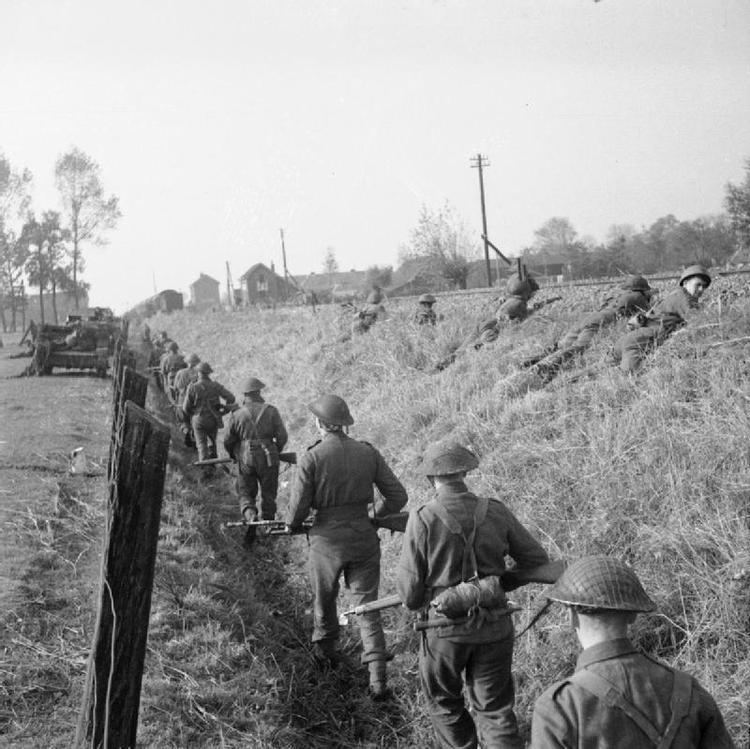Country United Kingdom Size Brigade | Branch British Army | |
 | ||
Active 1908–1919
1920–1946–Present Type Regular and Territorial Army Part of 53rd (Welsh) Infantry Division
1st (United Kingdom) Division | ||
The 160th Infantry Brigade and Headquarters Wales or Brigâd 160 (Cymru) is a regional brigade of the British Army that has been in existence since 1908, and saw service during both World War I and World War II, as part of the 53rd (Welsh) Infantry Division. It is a regional command responsible for all of Wales. The brigade organises an annual patrolling competition in the Brecon Beacons, known as Exercise Cambrian Patrol.
Contents
Formation
The Welsh Border Brigade was originally raised in 1908, upon creation of the Territorial Force, and was part of the Welsh Division. The brigade was composed of the 1st, 2nd and 3rd Volunteer battalions of the Monmouthshire Regiment along with the 1st Battalion of the Herefordshire Regiment.
First World War
In 1915 the brigade was redesignated the 160th (1/1st South Wales) Brigade and the Welsh Division the 53rd (Welsh) Division. The brigade fought with the division in the Great War, in the Middle Eastern theatre.
The brigade was reconstituted as a result of British troops being sent to the Western Front during the emergency following the German March 1918 Spring Offensive.
Order of battle
Between the wars
After the war the brigade and division were disbanded as was the Territorial Force. However, both the brigade and division were reformed in 1920 in the Territorial Army. The brigade, now the 160th (South Wales) Infantry Brigade, was again composed of the same four battalions it had before the Great War. However, these were all posted to the 159th (Welsh Border) Infantry Brigade early in the 1920s and were replaced by the 4th, 5th, 6th and 7th Battalions of the Welch Regiment. The 6th and 7th Battalions were amalgamated as the 6th/7th Battalion, Welch Regiment and the 4th Battalion, King's Shropshire Light Infantry joined in the same year.
Second World War
The brigade, now composed of two battalions of the Welch Regiment and one of the Monmouthshire Regiment, together with the rest of the 53rd (Welsh) Division, was mobilised in late August 1939 and soon afterwards Britain declared war on Nazi Germany. In April 1940 the 160th Brigade was sent to Northern Ireland and, after the British Expeditionary Force (BEF) was evacuated from France, the brigade was mainly involved in anti-invasion duties and exercises training to repel a potential German invasion of Northern Ireland. The 160th Brigade, and the rest of the 53rd Division, were sent to Southeast England almost two years later, where they began training for the eventual Allied invasion of Northern France.
After another nearly two years spent in Kent training, the brigade, under the command of Brigadier Charles Coleman, with the rest of the 53rd Division, landed in Normandy as part of Operation Overlord (codename for the Allied invasion of Northwest Europe) in late June 1944, and were almost immediately involved in severe attritional fighting around the French city of Caen, facing numerous German panzer divisions, in what came to be known as the Battle for Caen. The 160th Brigade later participated in the Second Battle of the Odon, sustaining heavy casualties, which resulted in the 1/5th Battalion, Welch Regiment being transferred to the 158th Brigade of the same division and replaced by the 6th Battalion, Royal Welch Fusiliers. The decision was made by the divisional commander, Major-General Robert Knox "Bobby" Ross (a former commander of the brigade), due to an acute shortage of infantrymen in the British Army at this stage of the war, even more so in finding sufficient numbers of battle casualty replacements (or reinforcements) for three battalions of the same regiment all serving together in the same brigade, which, like the 160th Brigade, had also suffered heavy losses. The brigade went on to fight in the Battle of Falaise, capturing large numbers of German troops as prisoners of war (POWs) and the subsequent Allied advance from Paris to the Rhine, later playing a minor role in the Battle of the Bulge, a large role in Operation Veritable in February 1945 and crossing the River Rhine into Germany over a month later, where it took part in the Western Allied invasion of Germany, finally ending the war in Hamburg, Germany.
The 160th Brigade remained in Germany on occupation duties until it was disbanded in late 1946.
Order of battle
The 160th Infantry Brigade was composed as follows during the war:
Commanders
The following officers commanded the 160th Infantry Brigade during the war:
Post war
After World War II the Territorial Army was reorganised as the TAVR. With the disbandment of 5th Division, the brigade came under the control of the new Support Command based in Aldershot, in April 2012.
Current formation
Under the Army 2020 concept, 160th (Wales) Brigade was renamed as 160th Infantry Brigade and Headquarters Wales. It is one of the seven Adaptable Force brigades. It comprises:
